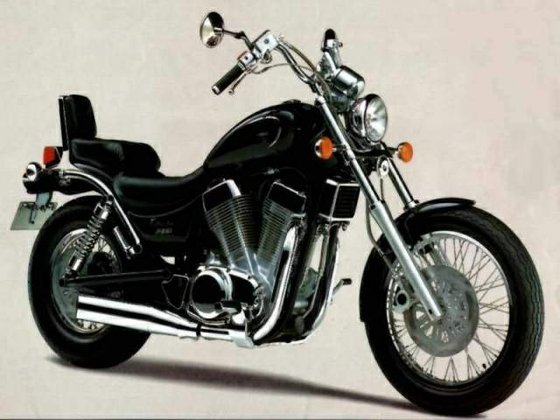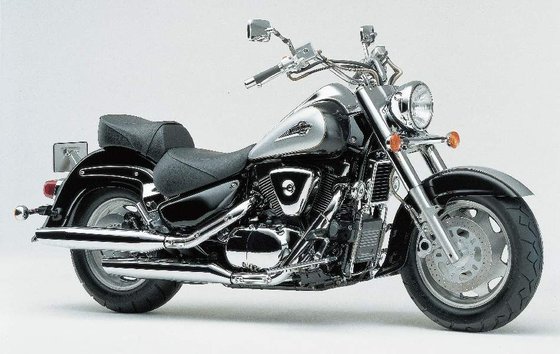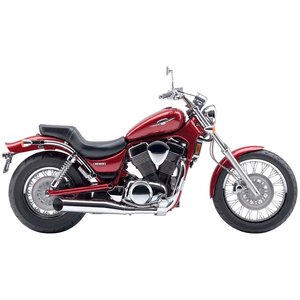Suzuki VS 1400 GLP Intruder (1987–2004): A Timeless Cruiser with Muscle and Attitude

Introduction
The Suzuki VS 1400 GLP Intruder isn’t just a motorcycle—it’s a statement. For nearly two decades, this V-twin cruiser carved its niche with a blend of raw power, minimalist chopper styling, and engineering that prioritized simplicity over frills. Riding the Intruder feels like stepping into a time capsule where torque reigns supreme, and every twist of the throttle is a reminder of why big-displacement cruisers dominated the ’90s. Whether you’re navigating city streets or cruising coastal highways, the Intruder demands attention—not just for its looks, but for the way it effortlessly marries brawn with purpose.
Design: Chopper Aesthetics Meet Japanese Precision

The Intruder’s design is a love letter to American chopper culture, reinterpreted through Suzuki’s pragmatic lens. Its 36-degree rake, stretched fork tubes, and slender 110/90-19 front tire give it a prow-forward stance that screams aggression. The 45-degree V-twin engine sits proudly at the heart of the bike, uncluttered by bulky airboxes or obtrusive wiring. Even the carburetors are tucked away—one nestled between the cylinders, the other hidden behind the engine—to maintain the bike’s clean lines.
Suzuki’s obsession with minimalism extends to the chassis. The frame is so narrow that it slips inside the swingarm pivot, a design quirk that contributes to the bike’s surprisingly low seat height (28.9–29.1 inches / 735–740 mm). This makes it accessible for shorter riders, though taller pilots might find the ergonomics cramped on long rides. The pullback handlebars force a relaxed posture, but at highway speeds, you’ll feel the wind pushing against your chest—a reminder that this bike was built for style as much as comfort.
The Intruder’s color palette—black, maroon, blue, and red—is understated, letting the mechanical details shine. Chrome accents are sparing but strategic, highlighting the exhaust headers and valve covers without venturing into gaudiness. It’s a bike that ages well, its design avoiding the dated flourishes that plague many ’90s cruisers.
Engine: Torque for Days, Character for Years
At the core of the Intruder beats a 1,360cc (83 cu in) air/oil-cooled V-twin, a motor that prioritizes low-end grunt over top-end theatrics. With 84.8 lb-ft (115 Nm) of torque peaking at just 3,200 rpm, the Intruder lunges forward with authority the moment you crack the throttle. Suzuki’s engineers achieved this using a clever 3-valve-per-cylinder setup (two intake, one exhaust), which optimizes airflow without complicating maintenance.
The switch from a 4-speed to a 5-speed transmission in 1997 was a game-changer. Earlier models (1987–1996) required frequent downshifts to stay in the powerband, but the 5-speed gearbox added a relaxed overdrive gear, dropping highway RPMs by 300 at 70 mph (113 km/h). Fuel efficiency improved too, with later models achieving up to 47 MPG (5.0 L/100 km).
Carburetion isn’t perfect—throttle response below 2,500 rpm feels lazy—but once the engine wakes up, it pulls with a linear, unhurried confidence. The exhaust note is muted, thanks to offset crankpins that reduce vibration, but it’s far from anemic. This isn’t a motor that begs to be redlined; it’s happiest churning out torque between 3,000–4,500 rpm, whether you’re carving through traffic or idling at a stoplight.
Handling: Stable, If Not Sporty
Don’t let the chopper profile fool you—the Intruder is more agile than it looks. The narrow front tire and 63.8-inch (1,620 mm) wheelbase lend it surprising stability in straight lines, while the low center of gravity makes slow-speed maneuvers manageable. That said, the steering geometry (6.5 inches / 165 mm of trail) demands deliberate input. At parking-lot speeds, the front end feels “floppy,” as if the fork wants to flop into a full lock without warning.
Push it harder, and the soft suspension reveals its limits. The 41mm telescopic fork dives noticeably under braking, and the twin rear shocks (adjustable for preload) struggle to absorb sharp bumps. Shaft drive introduces some “jacking” effect during hard acceleration, but it’s less intrusive than on many cruisers of the era.
Braking performance is adequate, not exceptional. The single 295mm front disc with a 2-piston caliper lacks initial bite, requiring a firm squeeze to shed speed. The rear 275mm disc is more communicative, making it easy to modulate in corners. Upgrading to sintered pads or a braided stainless line (both available at MOTOPARTS.store) can sharpen response.
Comfort: A Mixed Bag for Long Hauls
Suzuki prioritized form over function with the Intruder’s ergonomics. The narrow, sculpted seat looks great but offers minimal support—after an hour, you’ll be squirming for relief. The forward-set footpegs and pulled-back bars create a relaxed riding triangle, but taller riders may feel cramped, with knees bent sharply and elbows tucked in.
Passengers fare worse. The pillion pad is barely larger than a smartphone, and the passenger pegs are positioned high, forcing shorter riders into a knees-up stance. Add a windscreen (a popular aftermarket upgrade), and the Intruder becomes tolerable for day trips, but this isn’t a bike for cross-country touring.
Vibration is minimal, even at highway speeds—a testament to Suzuki’s counterbalancing. The mirrors stay clear, and your hands won’t go numb, but the lack of wind protection turns sustained 75+ mph (120+ km/h) runs into a battle against fatigue.
Competition: How the Intruder Stacks Up
In the ’90s cruiser wars, the Intruder faced stiff competition:
- Honda Shadow 1100: Honda’s V-twin offered smoother power delivery and a plusher ride but couldn’t match the Intruder’s torque (84.8 lb-ft vs. Shadow’s 72.3 lb-ft). Shaft drive gave the Suzuki an edge in maintenance simplicity.
- Yamaha Virago XV1100: The Virago’s monoshock rear and liquid-cooled engine were more modern, but its 60 HP paled next to the Intruder’s 72 HP. Yamaha’s design also aged less gracefully.
- Kawasaki Vulcan 1500: The Vulcan’s 1,500cc engine dwarfed the Intruder’s, but its extra weight (584 lbs vs. 560 lbs wet) made it feel sluggish in comparison.
Where the Intruder shines is its aftermarket support. Unlike rivals, its minimalist frame and timeless styling make it a favorite for customization—a boon for owners looking to tweak ergonomics or performance.
Maintenance: Keeping the Legend Alive
The Intruder’s air/oil-cooled engine and shaft drive make it a low-fuss companion. Key maintenance tips:
- Valve Adjustments: Hydraulic lifters eliminate the need for manual valve adjustments—a rarity in ’90s bikes. Just keep the oil fresh (10W-40, changed every 3,700 miles / 6,000 km).
- Carburetor Tuning: The Mikuni BDS36 carbs can gum up if left unused. A carb rebuild kit (available at MOTOPARTS.store) and annual fluid stabilizer will keep them crisp.
- Shaft Drive: Inspect the final drive oil every 15,000 miles (24,000 km). Use 90W GL-5 gear oil—it’s a 10-minute job.
- Brakes: Swap fluid every two years (DOT 4) and consider upgrading to braided lines for a firmer lever feel.
- Suspension: The soft rear shocks can be swapped for adjustable aftermarket units to improve load handling.
Common wear items like tires (110/90-19 front, 170/80-15 rear) and brake pads are widely available. For owners craving more power, jet kits and aftermarket exhausts can wake up the midrange—just expect a dip in fuel economy.
Final Thoughts
The Suzuki VS 1400 GLP Intruder isn’t perfect, but its flaws are part of its charm. It’s a cruiser that rewards riders who appreciate mechanical simplicity, stump-pulling torque, and head-turning design. While later models (1997–2004) ironed out the kinks with a 5-speed gearbox and refined ergonomics, even early Intruders remain sought after for their bulletproof reliability.
Whether you’re restoring a classic or daily-riding a well-loved example, MOTOPARTS.store has the components to keep your Intruder running—and turning heads—for another decade. From performance upgrades to chrome trim, this is a bike that invites tinkering. And really, what’s the point of owning a legend if you can’t make it your own?
Specifications sheet
| Engine | |
|---|---|
| Stroke: | Four-stroke |
| Ignition: | Digital transistorized |
| Max power: | 52 kW | 70.0 hp |
| Max torque: | 115 Nm |
| Fuel system: | 2 x Mikuni BDS36/BS36 carburetors |
| Lubrication: | Wet sump |
| Max power @: | 4800 rpm |
| Displacement: | 1360 ccm |
| Max torque @: | 3200 rpm |
| Configuration: | V |
| Cooling system: | Air/oil cooled |
| Compression ratio: | 9.3:1 |
| Number of cylinders: | 2 |
| Dimensions | |
|---|---|
| Wheelbase: | 1560 mm (61.4 in) |
| Dry weight: | 243 |
| Wet weight: | 262 |
| Seat height: | 701–740 mm (27.6–29.1 in) |
| Fuel reserve: | 3 L (0.8 US gal) |
| Overall width: | 724 mm (28.5 in) |
| Overall height: | 1220 mm (48.0 in) |
| Overall length: | 2334 mm (91.9 in) |
| Ground clearance: | 150 mm (5.9 in) |
| Fuel tank capacity: | 13 L (3.43 US gal) |
| Drivetrain | |
|---|---|
| Final drive: | shaft |
| Transmission: | 5-speed |
| Final reduction ratio: | 2.666:1 |
| Maintenance | |
|---|---|
| Rear tire: | 170/80-15 |
| Engine oil: | 10W40 |
| Front tire: | 110/90-19 |
| Idle speed: | 1000 ±50 rpm |
| Brake fluid: | DOT 4 |
| Spark plugs: | NGK DPR8EA-9 or NGK DPR8EIX-9 |
| Spark plug gap: | 0.9 |
| Forks oil capacity: | 0.708 |
| Engine oil capacity: | 5.0 |
| Final drive oil type: | 90W GL-5 |
| Final drive oil capacity: | 0.22 |
| Engine oil change interval: | Every 5000 km or 2 years |
| Valve clearance check interval: | Not required (hydraulic lifters) |
| Recommended tire pressure (rear): | 2.0 bar (29 psi) solo, 2.3 bar (33 psi) with passenger |
| Recommended tire pressure (front): | 2.0 bar (29 psi) |
| Performance | |
|---|---|
| Top speed: | 168.9 km/h (104.9 mph) |
| Standing ¼ mile: | 13.64 sec @ 152.4 km/h (94.7 mph) |
| Fuel consumption (average): | 5.0 L/100 km (47 US mpg) |
| Chassis and Suspension | |
|---|---|
| Rake: | 36° |
| Trail: | 165 mm (6.5 in) |
| Rear brakes: | Single 275 mm disc, 2-piston caliper |
| Front brakes: | Single 295 mm disc, 2-piston caliper |
| Rear suspension: | Twin shock, oil damped, 5-way adjustable spring preload |
| Front suspension: | 41 mm telescopic fork, coil spring, oil damped |
| Rear wheel travel: | 104 mm (4.1 in) |
| Front wheel travel: | 130 mm (5.1 in) |



















